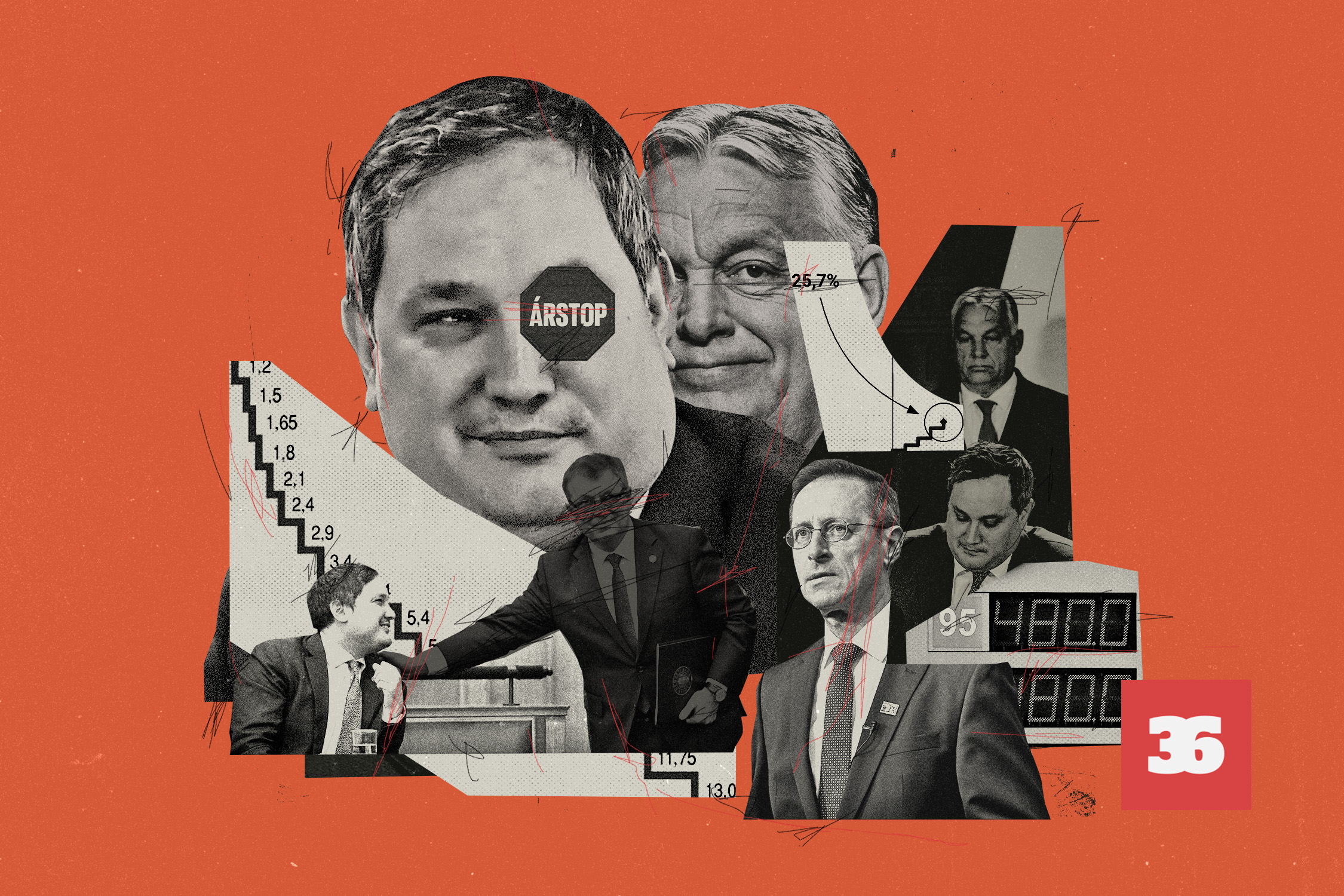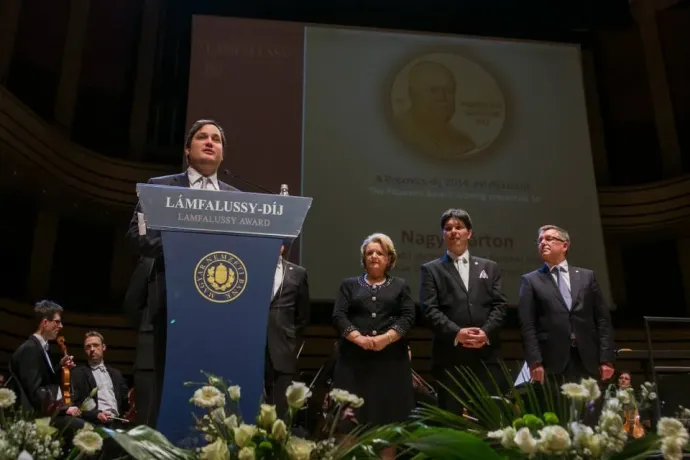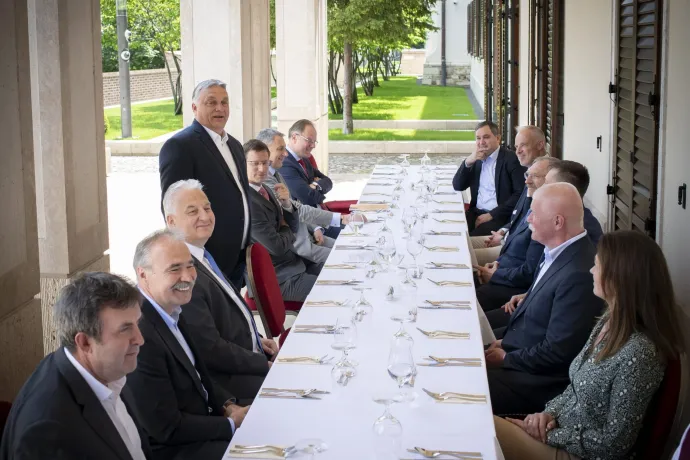Orbán and the economy, part two: Márton Nagy, the prime minister’s new economic magician

A meeting of the Orbán government in mid-spring ended in a heated debate.The meeting pitted two ambitious and high-profile members of the government, Márton Nagy and Péter Szijjártó, against each other.
The debate started when Nagy, who is in charge of economic development, brought up data published in April showing a significant drop in electric car sales across Europe since the beginning of the year. As Hungarian battery factories produce the batteries needed for electric cars, the drop in demand has also had an impact in Hungary, and from spring onwards production at Hungarian battery factories has slumped.
At the cabinet meeting, Nagy began to argue that the Hungarian government was not right to commit to the technology. The Szijjártó-led Ministry for Foreign Affairs and Trade, relying on the growing demand for electric cars, has been discussing and announcing new battery factory construction projects one after the other in recent years.
According to a source with information about the events, Nagy rather “vehemently” accused Szijjártó and the Foreign Ministry of misjudging the situation, saying they had “bet on the wrong horse.” According to the source, Szijjártó was not embarrassed, he entered the debate and tried to brush aside Nagy’s arguments. He hit back, saying that the market usually works in a way that an initial boom is followed by a slump, but that sales will recover to a higher level later on.
Join the Direkt36 supporters’ group and get insight into investigative journalism! Details →
The prime minister, who was present at the cabinet meeting, did not comment on the debate, but listened with interest to the clash between his two ministers. However, subsequent developments suggest that this episode did not hurt Márton Nagy’s standing. When Viktor Orbán reshuffled the powers of his ministers at the beginning of July, several tasks were transferred from Szijjártó to Nagy. These included, for example, determining from which countries guest workers could come to Hungary.
It was not only the minister of foreign affairs who lost ground to Márton Nagy. Nagy, who commands the title of minister of national economy, has expanded his portfolio at the expense of several other members of the government, including finance minister Mihály Varga, defense minister Kristóf Szalay-Bobrovniczky and justice minister Bence Tuzson. According to a government source, Nagy, who usually speaks in a confrontational style at cabinet meetings, makes no secret of the fact that he is stepping on the toes of other ministers and always speaks openly about it.
The minister usually explains this by saying that one of the government’s priorities, to kick-start economic growth, requires a strong ministry of economic affairs, and a strong ministry needs more and more new tools. His gradually expanding portfolio of responsibilities demonstrates that Orbán believes his economy minister’s arguments. As a result, Nagy has rapidly become a powerful member of the so-called internal government of ministers closest to Orbán, like Antal Rogán, cabinet chief of the prime minister and Gergely Gulyás, minister of the Prime Minister’s Office. They are the ones whom the prime minister not only instructs, but also listens to their opinions.
In essence, Márton Nagy has taken up the position previously held by György Matolcsy for decades alongside Orbán. As the first part of Direkt36’s series of articles showed, the prime minister has lost confidence in Matolcsy, who currently heads the Central Bank of Hungary (MNB), over the past few years and he has tried to get back into Orbán’s inner circle, but has not succeeded. For Matolcsy, this was particularly painful, because Márton Nagy had previously been his protégé at the central bank and it was through him that Orbán got to know Nagy. So, in other words, Matolcsy opened the way for Márton Nagy, who eventually knocked him out of the saddle.
In the second part of our series of articles on the functioning of Orbán’s economic policy that has been showing increasingly poor results in recent years, we focus on the rise of Márton Nagy, which has been full of personal dramatic twists and turns. Among other things, it reveals that Nagy played a major role in the economic policies of the 2022 election campaign, which contributed to another two-thirds Fidesz victory. For example, he came up with the idea of price caps, which government leaders embraced despite knowing that price restrictions would increase inflation.
This story tells us a lot, not only about the prime minister’s personnel policy, but also about how Orbán’s government regularly makes economic decisions that are politically beneficial in the short term despite them being known to cause problems in the long term.
We sent a detailed list of questions about the minister’s career to the Ministry of National Economy, but they only replied that “Márton Nagy was hired by Zsigmond Járai at the Central Bank of Hungary in 2002, where he worked until 2020, when he became chief economic advisor to prime minister Viktor Orbán.” Orbán’s press chief and Szijjártó’s foreign ministry did not respond to our request for comment.
I. NICE AND TOUGH

Márton Nagy did not restrain himself. Shortly after the 2010 parliamentary elections, the so-called professional staff of the MNB had a meeting. Normally, at meetings like these, senior MNB officials and lower level experts discuss the details of major central bank decisions before they are made. Márton Nagy was among those present. At the time he was in his mid-30s and was deputy director of the central bank’s financial stability department.
At one point, Nagy, who was slumped in his chair, was heard by one participant to say of one of the suggestions, “Fuck you all, this is bullshit!”
Nagy spoke like this even though the then president of the MNB, András Simor, was at the meeting. Simor did not use obscene language according to people who knew him. He was a president who was not very interested in appearances and was more concerned with finding good solutions to the various problems. And Nagy contributed to the discussion in a substantive way. According to one person present, Simor was impressed that his subordinate, who radiated “unabashed confidence”, was prepared and argued in a reasoned manner.
“He was very combative in defending his position in these meetings, it was overwhelming,” said one participant.
At the time, Márton Nagy had been working at the central bank for almost a decade, since 2002. His former colleagues described him as extremely bright, ambitious and “kind and funny” with his bosses, but firm with his subordinates. On one occasion, for example, he criticized a female colleague so harshly for a piece of her work that she left before the end of the working day.
Nagy’s career at the central bank began to take off during the economic crisis of 2008. According to a former colleague of his, this was due to Nagy’s work in the financial stability area, a department of the MNB that became extremely important during the financial crisis. “The crisis was a challenge for everyone. Nagy was working at 1500% and was very loyal,” said one of his former bosses.
The economic crisis further eroded support for already unpopular socialist governments, and among other things contributed to Fidesz’s landslide victory in 2010.
Orbán has entrusted the task of cleaning up the economy to the Ministry of National Economy (NGM), headed by György Matolcsy. When he was assembling his staff, Matolcsy also chose staff from the central bank, such as András Kármán, a senior director of the MNB, to be his finance secretary. This was a high profile position, as there was no separate Ministry of Finance at the time and financial policy management was concentrated in the top ministry covering several areas, which was being set up under Matolcsy.
Nagy eventually used this situation to move up the ranks of the MNB. According to sources familiar with what happened, he told Simor that he would prefer to stay at the central bank, but that he did not get on well with his immediate boss, the director of the financial stability area, Péter Tabák. Nagy was then working as his deputy. Simor himself was not happy with Tabák’s performance, and he did not want to lose Nagy. So the president of the central bank decided to dismiss Tabák and replace him with Nagy, who was seen as an emerging talent of the MNB.
Tabák, who is currently working at the European Bank for Reconstruction and Development, declined to comment on questions sent to him.
Meanwhile, Nagy was careful to stay close to Matolcsy’s circle, despite rejecting the ministry’s job offer. In the period after the formation of the government, he started to meet with the economy minister and his entourage. This information also spread within the MNB. Nagy was known to “know these guys,” a former central bank employee said, referring to senior politicians in the Orbán government. According to another former central bank employee, the phrase “I spoke to the minister” was repeatedly uttered by Nagy during this period.
This was unusual because relations between the government and the central bank were tense at the time. Orbán repeatedly attacked Simor, who was appointed during the socialist government, calling him an “offshore knight.” referring to the fact that the MNB governor had a company in Cyprus, which offered more favorable tax conditions. The conflict was further deepened by the Orbán government, which cut Simor’s salary by a quarter from 8 million forints (appr. 42 105 USD at the time) to 2 million forints (appr. 10 525 USD) by amending the central bank law. The NGM criticized the MNB because it said the central bank’s actions had not helped to stimulate economic growth.
Because of this, several people at the central bank saw it as a betrayal that one of their staff had close ties with the government, which had been harshly scourging them. However, this had no real consequences, as Simor’s term as president was coming to an end and everyone at the MNB was waiting to see who the prime minister would nominate to replace him.
Orbán’s choice was Matolcsy, who not only kept Márton Nagy after taking over the helm of the central bank in 2013, but soon promoted him to a senior position.
II. THE PERFECT TIMING

As the end of 2014 approached, central bank leaders were already planning a winter break. This was interrupted by Márton Nagy, who tried to convince Ádám Balog, a confidant of Matolcsy and a vice-president of the MNB, that the process of monetising foreign currency loans should be completed as quickly as possible. This was of huge significance, because according to central bank data, there were more than 700 000 foreign currency contracts signed by Hungarians at the beginning of 2014.”I can feel that there is going to be trouble,” said Nagy to Balog, according to a central bank source.
After Balog was finally convinced, he and Nagy went to Matolcsy, and persuaded him to speed up the planned process. They told him that the exchange of loans in foreign currency to Hungarian forint should be pushed through quickly, and that the central bank’s treasury would be able to cope.The complicated maneuver not only involved the conversion of retail loans into forints but also the repayment of foreign currency loans taken out by banks. The central bank helped with the latter by providing the banks with the necessary foreign currency. Matolcsy finally accepted the opinion of his subordinates, and convinced the prime minister of the importance of speeding up this process.
At the end of November, Parliament passed a law that automated the exchange of foreign currency mortgage contracts to forints. The timing for this law couldn’t have been more perfect. The Swiss central bank announced in mid-January 2015 that it would allow the Swiss franc to revalue. This caused the Swiss franc’s forint exchange rate to jump from 266 to 316 in a single day. However, this no longer affected foreign currency borrowers who were covered by the law on revaluation. Hungarian debtors were spared a total debt increase of 700 billion forints (appr. 2,6 billion USD at the time). The international press was quick to praise the Hungarian government’s timing. For example, the US news agency Bloomberg headlined an article on the subject as “Hungary’s Orban makes world’s best trade on Swiss franc loans”.
Although the idea came from Nagy, it was Matolcsy who was the one who made it a success, since the MNB, which he heads, was responsible for the transaction. According to sources familiar with him, Matolcsy has always had a knack for bringing in young, ambitious professionals. These young talents included Ádám Balog, former deputy state secretary of the NGM and former MNB vice-president; László Windisch, former MNB vice-president and current president of the State Audit Office of Hungary; Barnabás Virág, current MNB vice-president; and, of course, Márton Nagy.
Matolcsy also outsourced some of the work to them because, even as central bank president, he preferred to focus on big visions, the economy as a whole, rather than the day-to-day management of monetary policy.
“Matolcsy’s ambition has always been to be Orbán’s tell-all man,” said a former senior central bank official.
As Márton Nagy was the monetary expert among the young people close to Matolcsy, the central bank president began to rely on him more and more to shape monetary policy, and in 2015 he became one of the MNB’s vice-presidents. “Márton Nagy’s good quality is that he takes the burden off his boss’s shoulders,” said an acquaintance who said Nagy’s work ethic helped him move quickly.
Although Nagy worked hard, he also became self-reliant, which led to the first cracks in his relationship with Matolcsy.
III. SHOCK THERAPY

Márton Nagy, as the vice-president in charge of monetary policy, essentially oversaw the central activities of the MNB. According to one source familiar with the central bank’s operations, “Marci was creative, used a variety of tools” and sometimes applied solutions that Matolcsy, who was less interested in monetary policy, could not detect.
One example of this was the creation of a separate benchmark interest rate in addition to the central bank base rate, which influences the exchange rate of the forint and the interest rate on forint loans. This was an unusual move because normally the base rate should be the benchmark. Under Márton Nagy, however, the base rate became meaningless, and the interest rate that banks received after they had tied up their money with the MNB for a shorter period – a day or a week – became the benchmark. This construction influenced banks’ behavior.
Nagy created a complex system of multiple interest rates. According to sources familiar with the MNB’s operations, this created a situation where Matolcsy did not understand the change in interest rate policy beforehand, but only realized what it was after he had voted for it and seen the market reaction.
“Matolcsy is not getting any younger, he’s close to 70, it’s getting harder to keep track of everything,” said one source on the events that led to tensions between Nagy and Matolcsy.
In the meantime, Nagy continued to build up his reputation by drawing more and more spotlight to himself. He communicated the decisions of the Monetary Council, the main decision-making body of the central bank, to the public, and also gained recognition within the financial community for his tougher stance on Hungarian banks than his predecessors. In addition to his characteristic arrogance, he also blamed the banks for the disastrous effects of the spread of foreign currency loans.
So when he took up the top position at the MNB, he not only made a difference by micro-managing the field with a number of detailed rules, but also by adopting a very tough negotiating style with the banks’ representatives. “Marci was shock therapy,” said an acquaintance of Nagy. “They thought they were going for a friendly chat. Then it turned into sadomasochism, with Marci holding the whip,” said one source. Nagy’s aggressive style hit the banks’ representatives in the face.
After a while, the monetary expert came to the attention of Viktor Orbán. According to a state official working in the economic field, Orbán explicitly encouraged all of his ministers and heads of state institutions to bring a young official to their meeting. On several occasions, Matolcsy took Márton Nagy with him to these meetings.
Nagy then began to seek the company of various government officials. According to one of his acquaintances, he regularly met with government officials such as Antal Rogán, who was also interested in economic issues, and János Lázár, who was still a very influential minister at the time. “Márton Nagy was buzzing, present, solving problems,” said one of his acquaintances, suggesting that these meetings were related to various economic issues.
As both Nagy and Matolcsy are competitive characters with a strong sense of self-confidence, Nagy’s increasingly assertive stance has caused tension between the two economic experts.
“Márton Nagy went ahead, he was young, he didn’t want to get stuck under Matolcsy … and Matolcsy was afraid that Nagy would outgrow him,” said a source who knew the two closely.
The tension eventually led to Nagy’s departure from the central bank at the end of May 2020. Although the MNB’s official announcement said he had resigned as vice-president, several sources with close knowledge of the central bank’s operations said the break was Matolcsy’s imperative.
After his departure, Nagy tried unsuccessfully to find a job in several places, including at OTP Bank, one of the most important financial institutions in Hungary. “Nagy would have had little place there anyway. Csányi is not very fond of young, pompous characters. And he has a very different idea of economic policy,” said a source familiar with the events. This was a reference to the fact that Sándor Csányi, chairman of OTP, is opposed to excessive government intervention in the economy, unlike Márton Nagy. (OTP said they are not allowed to give out any information about applicants for their jobs. “However, if the minister is thinking of a career change, he is welcome to join OTP Bank,” they added, referring to Márton Nagy.)
A few weeks later, at the end of June 2020, it was revealed that Nagy had been appointed chief economic adviser to the prime minister. According to a senior government official, Orbán’s conscious efforts to rejuvenate his own backbench from 2014 onwards played a role. As part of this, he was looking for talented individuals like Péter Szijjártó, Antal Rogán and Gergely Gulyás, on whom he could rely in government. And Márton Nagy, who was in his early 40s at the time and had already proved himself alongside Matolcsy, was a good choice.
But his emergence eventually led to conflicts within the government.
IV. ORBÁN’S NEW MAGICIAN

In May 2022, shortly after another two-thirds Fidesz election victory, the finance minister Mihály Varga called a meeting of some 50-70 of his subordinates. The staff gathered in the impressive glass-roofed Cashier’s Hall in the ministry’s József Nádor Square building. Varga calmly and objectively listed the departments and tasks that will be transferred from his ministry to the new Ministry of Economic Development under Márton Nagy.
“You could sense that it was not his decision,” said one of the people present, who said that Varga had used language in his speech to imply that the changes had occurred over his head, such as “this decision was made.”
The room was mainly occupied by staff whose departments had been transferred. They did not say so at the time of the announcement, but the reorganization was not welcomed with great enthusiasm. Varga’s image within the Finance Ministry was positive, and he and his under-secretaries were regarded as gentlemen by their subordinates. In contrast, Márton Nagy had a rather bad reputation. According to a source at the Finance Ministry, he was described as ‘an animal’ who did not even say hello to his subordinates.
This episode also showed that in two years Nagy had become so powerful that he had not only been promoted to minister, but had also been able to expand at the expense of Orbán’s old confidants such as Varga. “He was in the club,” said a source close to the government. Nagy was among a select group of government politicians who came up with the main measures for the 2022 campaign, and thus contributed to Fidesz’s election victory.
The governing party leadership faced a new situation in 2021, the first time since 2010 that they were seriously worried about a possible opposition victory. This motivated them to embark on a campaign of handouts totalling thousands of billions of forints. During the campaign, they refunded social security contributions for those raising children, gave back the 13th month pension taken away by the socialists and gave police and military personnel a pay rise.
According to a source close to the government, these measures were invented by Orbán’s inner circle. Among them were Antal Rogán, the prime minister’s cabinet chief, who managed Fidesz’s election campaigns, and Márton Nagy, who was still acting as the prime minister’s chief economic adviser.
While the government was working on the details of these measures, inflation reached 5 percent, prompting the central bank to raise interest rates in June 2021 after a long delay. The central bank’s logic was that rising interest rates would cause households and businesses to borrow less and cut back on spending, leading to a fall in demand and ultimately a slowdown in inflation. It was clear that government handouts were going against the central bank’s objectives. After all, if voters have access to more money, it will boost demand and subsequently cause further inflation, which is exactly what the central bank was trying to limit.
The government, however, did not change its mind and began handing out money at the end of 2021 at the suggestion of Márton Nagy. These measures, in reaction to problems of increases in the price of consumer goods, reminded government critics of socialism. The price of petrol was capped at 480 forints (appr. 1,6 USD at the time) per liter and the price of basic food items was capped as well. According to a government source with insight into the related decisions, the price freezes were introduced by the government despite them being fully aware that they would lead to more inflation. The policy even had limited success with reducing strain on consumers as shops often compensated for the losses caused by price caps by increasing the prices of other products.
Orbán’s strategy, complemented by a message of peace in response to Russia’s attack on Ukraine, paid off in the short term, dealing a heavy blow to the opposition. In the meantime, however, inflation had run out of control, in large part because of the government’s actions.
However, the prime minister was still satisfied with Nagy’s performance. Orbán appointed him minister of economy and immediately invited him to the so-called inner circle of ministers.
According to a source close to the government, there are two categories of cabinet members. The first category includes those whom Orbán trusts politically, such as foreign minister Péter Szijjártó. The second category is made up of ministers with whom Orbán does not speak regularly and who have no substantive influence in their own areas. These include former human resources minister Miklós Kásler or János Csák, the minister of culture and innovation, who left his post after the EP elections in June this year.
“These ministers are playing the part, but they are not in the circle where things are decided,” said the source, who said “Marci is not a part-playing minister.”
And there was indeed plenty for Nagy to do in his new role.
V. AGAINST MATOLCSY AND VARGA

After the election, it became clear that the budget, which had been wrecked by campaign handouts, had to be put right and Orbán had to decide who to listen to among his two ministers for economic affairs.
The Varga-led Ministry of Finance was considering classic austerity measures, such as narrowing the scope of those who would benefit from the utility cuts, one of the signature measures implemented by the Fidesz government years ago. Márton Nagy, on the other hand, said there was no need to touch public spending and that it is possible to fill the budget holes by imposing various special taxes. According to a government source familiar with the internal discussions on this issue, Nagy was still confident that the war would soon be over, that its negative economic effects would quickly disappear and that the special taxes could be phased out.
Orbán accepted the solution proposed by Márton Nagy. At the end of May 2022, the government announced that banks, airlines, retail chains, among others, would be obliged to pay a large part of their “extra profits” into the budget.
But the government was still not out of the woods. In 2022, With energy prices soaring because of the war, they were forced to do in the summer what Mihály Varga had already called for in the spring. They resorted to one of their most symbolic measures, they cut tariffs. This meant that consumers of more electricity and gas than the average had to pay market prices. They also narrowed the circle of people who could access petrol with a price cap. As these restrictions were lifted, the price increases rippled through the economy and further fuelled inflation. It reached 15.6 percent by August 2022, one of the highest in the EU.
Meanwhile, the inflation-fighting central bank kept raising interest rates. While the base rate stood at 0.6 percent in summer 2020, it reached 13 percent in September 2022. This was already very high, even before the economic crisis of 2008. However, when the central bank raised the base rate from 11.75 percent to 13 percent at the end of September 2022, Matolcsy made a decision that later proved to be wrong. He said that the rate rise cycle has ended, so that “everyone could see that it was over.” He implied that the central bank does not plan any further rate hikes in the near future.
“Matolcsy had just made a huge mistake,” said a source familiar with the central bank’s operations. Based on the central bank’s previous statements, the market had expected further rate increases, but as this did not happen, the value of the forint fell further. In two weeks, the euro has jumped from 406 to 430 forints. In mid-October 2022, the central bank was forced to take action to protect the forint, leaving the base rate unchanged but raising the policy rate to a brutally high 18 percent.
The president of the Hungarian Chamber of Commerce and Industry, László Parragh, who is closely associated with the government, was outraged by the decision. The same day, he said that the extremely high interest rates would bankrupt a large number of businesses because they would not have access to affordable credit. According to a source close to Márton Nagy, the minister of economy also criticized the decision of the central bank, which had narrowed its room for maneuver for a long time. High interest rates are not the way to generate economic growth.
“The government was right to say, ‘Stop it, Gyuri, relax’,” the source said, referring to the growing frustration with Matolcsy within the government.
It was after such a backdrop that at the economic committee hearing which took place in early December 2022, Matolcsy tried to shift the blame for the difficulties onto the government. Some of his criticisms were directed at the economy minister, as he said that the price freezes linked to Márton Nagy had caused inflation to rise by 3-4 percent.
Inflation peaked at 25.7 percent in January 2023 and then fell to 9.9 percent in October 2023, in line with government promises. This dip was partly because of a fall in international energy prices, which the government had nothing to do with. And, of course, the price increases of energy did not disappear when inflation slowed, the pace just slowed.
Nagy was also very active during this period, with his ministry introducing a price monitoring system that put shops in competition with each other. These ideas also won Orbán’s approval. As a result of the prime minister’s approval, in December 2023 Nagy took over the economic cabinet from Mihály Varga, which included several government ministers. “This decision was about formalizing Nagy’s informal influence,” said a source close to Varga.
Varga and Matolcsy had very different experiences of Márton Nagy’s rise. Varga has not made public his loss of position. “His attitude was that it is what it is, he thought that Márton Nagy was also a János Lázár type, and he would pop out one day,” said a source who regularly spoke to the finance minister. He was referring to the fact that Lázár was previously the most powerful minister for a while, but in 2018 he was no longer in the government, only to be reappointed in 2022.
Matolcsy has followed a very different strategy, and in March this year he took on Nagy more directly than ever before. Speaking at an event at the Budapest Stock Exchange, he said he felt bad that the attacks on the central bank were being led by his former deputy, Márton Nagy. Then, dissecting the two’s history together, he said that he had previously had to “kick Nagy out” of the central bank.
“As I told the prime minister, he made significant professional mistakes and his management style was unacceptable,” the MNB president explained.
Reacting to what was said, Nagy hit back by saying that “between 2013 and 2020, it was György Matolcsy, now I have a different boss. Thank God!”
Join the Direkt36 supporters’ group and get insight into investigative journalism! Details →
The conflict has escalated to the point where, according to several government sources, Orbán has decided to intervene. He ordered Nagy and Matolcsy to sit down and discuss their differences. According to the source, Orbán’s position was that instead of fighting in public in a difficult economic situation, the parties should concentrate on getting the economy back on track. Subsequently, Nagy met Matolcsy in early April this year and a picture of the meeting was published, showing the minister and the central bank governor shaking hands.
However, the peace deal was not a complete success. In mid-May, the central bank harshly criticized the government’s competitiveness strategy, to which Nagy responded by saying that the MNB was unwilling to cooperate. In September, Matolcsy reiterated his criticisms and said that a complete turnaround in economic policy was needed. According to a source close to the government, the government is now playing a waiting game, as Matolcsy’s central bank presidency is coming to an end. “Until then, we can manage it” Balázs Orbán, the prime minister’s political director, said in September, referring to the fact that Matolcsy’s term ends in March.
Nagy, meanwhile, has been directed by Orbán to kick-start economic growth. According to a government source, this is key for the government because if growth picks up, consumption will increase, and more taxes will flow in as consumption grows. “If there is more tax revenue, then more investment can be made. With it, it will be better for the 2026 elections,” the source explained.
So far, there is little sign that growth is picking up. The second-quarter GDP data published at the end of July also came in below expectations. While analysts had expected growth, the Hungarian economy’s output fell by 0.2 percent compared to the previous quarter, partly due to a slump in domestic battery production as demand for electric cars declined.
Of course, his room for maneuver is severely limited by his boss’s vision of the economy. In recent years, Orbán has become more and more confident in his ability to dictate policy in this area too. This is the subject of the next, final part of our series of articles.
Bence Széchenyi contributed to the translation of this article.
Cover picture: Somogyi Péter (szarvas) / Telex ; Fotó: MTI, Telex




